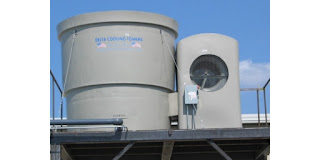Delta Cooling Towers specializes in the design and construction of corrosion resistant cooling towers and similar equipment. Much of the tower construction is HDPE or other non-metallic material, enabling the company to offer a 20 year warranty on their equipment.
Cooling towers are employed worldwide in HVAC applications and process fluid cooling. In addition to their industry leading corrosion resistance, Delta Cooling Towers also offers anti-microbial protection which combats the growth of microbes responsible for Legionnaires Disease and other respiratory ailments. The various product lines cover heat transfer capacities to accommodate any installation.
There is a lexicon employed in the description of cooling tower performance and operation. Some commonly used terms, along with their meaning, is provided below. The terms and their meanings is pulled from the owner’s manual provided by Delta Cooling Towers for their Pioneer series of forced draft cooling towers.
Share your process and HVAC cooling challenges with application experts, leveraging your own knowledge and experience with their product application expertise to develop an effective solution.
Cooling Tower Terms and Definitions
- BTU – A BTU is the heat energy required to raise the temperature of one pound of water one degree Fahrenheit in the range from 32° F. to 212° F.
- Cooling Range – The difference in temperature between the hot water entering the tower and the cold water leaving the tower is the cooling range.
- Approach – The difference between the temperature of the cold water leaving the tower and the wet-bulb temperature of the air is known as the approach. The approach fixes the operating temperature of the tower and is a most important parameter in determining both tower size and cost.
- Drift – The water entrained in the air flow and discharged to the atmosphere. Drift loss does not include water lost by evaporation. Proper tower design and operation can minimize drift loss.
- Heat Load – The amount of heat to be removed from the circulating water through the tower. Heat load is equal to water circulation rate (gpm) times the cooling range times 500 and is expressed in BTU/hr. Heat load is also an important parameter in determining tower size and cost.
- Ton – An evaporative cooling ton is 15,000 BTU’s per hour.
- Wet-Bulb Temperature – The lowest temperature that water theoretically can reach by evaporation. Wet-Bulb Temperature is an extremely important parameter in tower selection and design and should be measured by a psychrometer.
- Pumping Head – The pressure required to pump the water from the tower basin, through the entire system and return to the top of the tower.
- Make-Up – The amount of water required to replace normal losses caused by bleedoff, drift, and evaporation.
- Bleed Off (Blowdown) – The circulating water in the tower which is discharged to waste to help keep the dissolved solids concentrating in the water below a maximum allowable limit. As a result of evaporation, dissolved solids concentration will continually increase unless reduced by bleed off.
